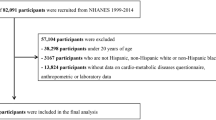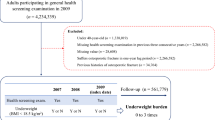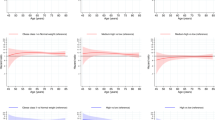Abstract
Objectives:
To investigate the dose–response association between body mass index (BMI) in young adulthood and the risk of mortality caused by unintentional injuries.
Methods:
We performed a cohort study including 7 43 398 men identified by linkage of the Multigeneration Register and the Military Service Conscription Register. Cox regression models were used to examine crude and adjusted hazard ratios (HRs) and 95% confidence intervals (95% CIs) of the relationships between BMI at age 18–20 years and the risk of death from all unintentional injuries as well as from specific unintentional injuries. We then estimated the population attributable fractions (PAFs)—the proportion of unintentional deaths that was attributable to underweight, overweight and obesity in this population-based cohort.
Results:
During 35.9 years of follow-up, 6461 deaths occurred from unintentional injuries, including 3064 deaths from road injury, 978 from poisoning, 503 from falls, 243 from fire and 348 from drowning. Underweight subjects had a higher risk of mortality in all unintentional injuries (HR, 1.05; 95% CI, 1.03–1.10) and mortality in burns (HR, 1.65; 95% CI, 1.13–2.40) compared with BMI between 18.5 and 22.5 kg m−2 (reference group). BMI >25 kg m−2 was associated with increased risk of death from all unintentional injuries (HR, 1.36; 95% CI, 1.12–1.65) and road accidents (HR, 1.50; 95% CI, 1.14–1.97). Estimates of PAF suggested that 4.4% of the mortality in Swedish men caused by unintentional injuries could have been avoided if BMI values were kept between 18.5 and 22.5 kg m−2.
Conclusions:
A U-shaped association was observed between BMI and risk of unintentional death. Both underweight and overweight were associated with increased mortality risk for all unintentional injuries and for subtype causes. Our study suggests that BMI might be a significant target for preventive interventions on deaths caused by unintentional injuries.
This is a preview of subscription content, access via your institution
Access options
Subscribe to this journal
Receive 12 print issues and online access
$259.00 per year
only $21.58 per issue
Buy this article
- Purchase on Springer Link
- Instant access to full article PDF
Prices may be subject to local taxes which are calculated during checkout


Similar content being viewed by others
References
Rahman F, Andersson R, Svanstrom L . Medical help seeking behaviour of injury patients in a community in Bangladesh. Public Health 1998; 112: 31–35.
Zwi AB, Forjuoh S, Murugusampillay S, Odero W, Watts C . Injuries in developing countries: policy response needed now. Trans R Soc Trop Med Hyg 1996; 90: 593–595.
Mattila VM, Parkkari J, Korpela H, Pihlajamaki H . Hospitalisation for injuries among Finnish conscripts in 1990-1999. Accident Anal Prev 2006; 38: 99–104.
de Ramirez SS, Hyder AA, Herbert HK, Stevens K . Unintentional injuries: magnitude, prevention, and control. Annu Rev Public Health 2012; 33: 175–191.
World Health Organization Global Burden of Disease: 2004 Update. WHO: Geneva, 2008.
Singh GK, Yu SM . Trends and differentials in adolescent and young adult mortality in the United States, 1950 through 1993. Am J Public Health 1996; 86: 560–564.
Wang Y, Beydoun MA . The obesity epidemic in the United States - gender, age, socioeconomic, racial/ethnic, and geographic characteristics: a systematic review and meta-regression analysis. Epidemiol Rev 2007; 29: 6–28.
Kark M, Rasmussen F . Increasing trends in overweight and obesity among young men in Sweden 1970-2000. Is the socio-economic gap growing? Int J Obesity 2004; 28: S22–S22.
Calle EE, Thun MJ, Petrelli JM, Rodriguez C, Heath CW Jr . Body-mass index and mortality in a prospective cohort of U.S. adults. N Engl J Med 1999; 341: 1097–1105.
Zhu SK, Kim JE, Ma XG, Shih A, Laud PW, Pintar F et al. BMI and risk of serious upper body injury following motor vehicle crashes: concordance of real-world and computer-simulated observations. PLoS Med 2010; 7: e1000250.
Kuehl KS, Kisbu-Sakarya Y, Elliot DL, Moe EL, DeFrancesco CA, MacKinnon DP et al. Body mass index as a predictor of firefighter injury and workers' compensation claims. J Occup Environ Med 2012; 54: 579–582.
Grundstrom AC, Guse CE, Layde PM . Risk factors for falls and fall-related injuries in adults 85 years of age and older. Arch Gerontol Geriatr 2012; 54: 421–428.
Chasse M, Fergusson DA, Chen Y . Body mass index and the risk of injury in adults: a cross-sectional study. Int J Obes (Lond) 2014; 38: 1403–1409.
Zhu SK, Layde PM, Guse CE, Laud PW, Pintar F, Nirula R et al. Obesity and risk for death due to motor vehicle crashes. Am J Public Health 2006; 96: 734–739.
Jelenkovic A, Silventoinen K, Tynelius P, Rasmussen F . Association of paternal IQ in early adulthood with offspring mortality and hospital admissions for injuries: a cohort study of 503 492 Swedish children. J Epidemiol Community Health 2014; 68: 679–682.
Batty GD, Wennerstad KM, Smith GD, Gunnell D, Deary IJ, Tynelius P et al. IQ in early adulthood and mortality by middle age: cohort study of 1 million Swedish men. Epidemiology 2009; 20: 100–109.
Eveleth PB . Physical status: the use and interpretation of anthropometry. Report of a WHO Expert Committee - WHO. Am J Hum Biol 1996; 8: 786–787.
de Gonzalez AB, Hartge P, Cerhan JR, Flint AJ, Hannan L, MacInnis RJ et al. Body-mass index and mortality among 1.46 million white adults. N Engl J Med 2010; 363: 2211–2219.
Vandenbroucke JP, von Elm E, Altman DG, Gotzsche PC, Mulrow CD, Pocock SJ et al. Strengthening the Reporting of Observational Studies in Epidemiology (STROBE): explanation and elaboration. Int J Surg 2014; 12: 1500–1524.
Batty GD, Wennerstad KM, Smith GD, Gunnell D, Deary IJ, Tynelius P et al. IQ in early adulthood and mortality by middle age cohort study of 1 million Swedish men. Epidemiology 2009; 20: 100–109.
Lawlor DA, Sterne JAC, Tynelius P, Smith GD, Rasmussen F . Association of childhood socioeconomic position with cause-specific mortality in a prospective record linkage study of 1,839,384 individuals. Am J Epidemiol 2006; 164: 907–915.
Silventoinen K, Magnusson PKE, Tynelius P, Kaprio J, Rasmussen F . Heritability of body size and muscle strength in young adulthood: a study of one million Swedish men. Genet Epidemiol 2008; 32: 341–349.
Harrell FE . Regression Modeling Strategies: With Applications to Linear Models, Logistic Regression, and Survival Analysis. Springer: New York, NY, USA, 2001.
Chen YQ, Hu C, Wang Y . Attributable risk function in the proportional hazards model for censored time-to-event. Biostatistics 2006; 7: 515–529.
Laaksonen MA, Knekt P, Harkanen T, Virtala E, Oja H . Estimation of the population attributable fraction for mortality in a cohort study using a piecewise constant hazards model. Am J Epidemiol 2010; 171: 837–847.
Troiano RP, Frongillo EA, Sobal J, Levitsky DA . The relationship between body weight and mortality: a quantitative analysis of combined information from existing studies. Int J Obesity 1996; 20: 63–75.
Stoohs RA, Guilleminault C, Itoi A, Dement WC . Traffic accidents in commercial long-haul truck drivers: the influence of sleep-disordered breathing and obesity. Sleep 1994; 17: 619–623.
Philip P . Sleepiness of occupational drivers. Ind Health 2005; 43: 30–33.
Teran-Santos J, Jimenez-Gomez A, Cordero-Guevara J, Burgos-Santander CG . The association between sleep apnea and the risk of traffic accidents. New Engl J Med 1999; 340: 847–851.
Wiegand DM, Hanowski RJ, McDonald SE . Commercial drivers' health: a naturalistic study of body mass index, fatigue, and involvement in safety-critical events. Traffic Inj Prev 2009; 10: 573–579.
Fjeldstad C, Fjeldstad AS, Acree LS, Nickel KJ, Gardner AW . The influence of obesity on falls and quality of life. Dyn Med 2008; 7: 4.
Friedmann JM, Elasy T, Jensen GL . The relationship between body mass index and self-reported functional limitation among older adults: a gender difference. J Am Geriatr Soc 2001; 49: 398–403.
Rockett IRH, Hobbs G, De Leo D, Stack S, Frost JL, Ducatman AM et al. Suicide and unintentional poisoning mortality trends in the United States, 1987-2006: two unrelated phenomena? BMC Public Health 2010; 10: 705.
Elia M . Changing concepts of nutrient requirements in disease: implications for artificial nutritional support. Lancet 1995; 345: 1279–1284.
Gupta R, Knobel D, Gunabushanam V, Agaba E, Ritter G, Marini C et al. the effect of low body mass index on outcome in critically ill surgical patients. Nutr Clin Pract 2011; 26: 593–597.
Ryan CM, Schoenfeld DA, Thorpe WP, Sheridan RL, Cassem EH, Tompkins RG . Objective estimates of the probability of death from burn injuries. New Engl J Med 1998; 338: 362–366.
Flegal KM, Graubard BI, Williamson DF, Gail MH . Cause-specific excess deaths associated with underweight, overweight, and obesity. JAMA 2007; 298: 2028–2037.
Thorogood M, Appleby PN, Key TJ, Mann J . Relation between body mass index and mortality in an unusually slim cohort. J Epidemiol Community Health 2003; 57: 130–133.
Batty GD, Gale CR, Tynelius P, Deary IJ, Rasmussen F . IQ in early adulthood, socioeconomic position, and unintentional injury mortality by middle age: a cohort study of more than 1 million Swedish men. Am J Epidemiol 2009; 169: 606–615.
Batty GD, Deary IJ, Schoon I, Gale CR . Childhood mental ability in relation to food intake and physical activity in adulthood: the 1970 British cohort study. Pediatrics 2007; 119: E38–E45.
Soori H . Developmental risk factors for unintentional childhood poisoning. Saudi Med J 2001; 22: 227–230.
Schwebel DC, Brezausek CM, Ramey SL, Ramey CT . Interactions between child behavior patterns and parenting: implications for children's unintentional injury risk. J Pediatr Psychol 2004; 29: 93–104.
Morrongiello BA, Dawber T . Parental influences on toddlers' injury-risk behaviors: are sons and daughters socialized differently? J Appl Dev Psychol 1999; 20: 227–251.
Krul AJ, Daanen HA, Choi H . Self-reported and measured weight, height and body mass index (BMI) in Italy, the Netherlands and North America. Eur J Public Health 2011; 21: 414–419.
Connor Gorber S, Tremblay M, Moher D, Gorber B . A comparison of direct vs. self-report measures for assessing height, weight and body mass index: a systematic review. Obes Rev 2007; 8: 307–326.
Rasmussen F, Johansson M, Hansen HO . Trends in overweight and obesity among 18-year-old males in Sweden between 1971 and 1995. Acta Paediatr 1999; 88: 431–437.
Acknowledgements
We are indebted to all participants in the study and are grateful to the Sweden Conscription group.
Author information
Authors and Affiliations
Corresponding author
Ethics declarations
Competing interests
The authors declare no conflict of interest.
Additional information
Supplementary Information accompanies this paper on International Journal of Obesity website
Supplementary information
Rights and permissions
About this article
Cite this article
Jia, T., Tynelius, P. & Rasmussen, F. U-shaped association of body mass index in early adulthood with unintentional mortality from injuries: a cohort study of Swedish men with 35 years of follow-up. Int J Obes 40, 809–814 (2016). https://doi.org/10.1038/ijo.2015.239
Received:
Revised:
Accepted:
Published:
Issue Date:
DOI: https://doi.org/10.1038/ijo.2015.239



